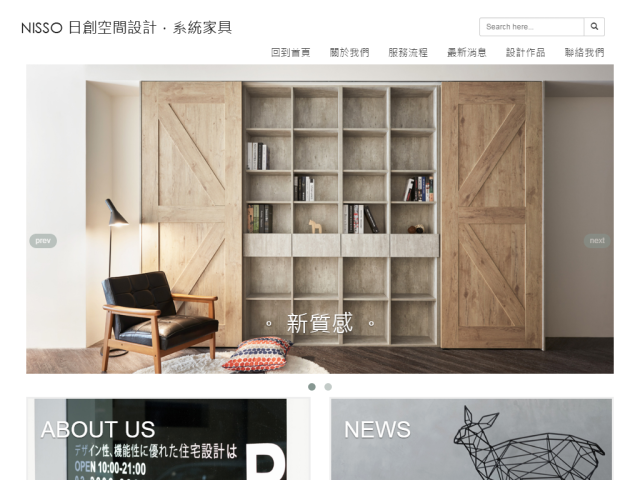文網系統開發個案比較表
本表為文網股份有限公司開發系統個案中節錄的分析表。
專題文章 / 2011-02-01
貨運業資料庫網站式系統程式設計完成
CADCH接受委託貨運系統全雲端化系統開發完成,只要能連上網路就可以使用。
大量利用jQuery跟AJAX提昇UI操作親切度,而且完全沒使用FLASH所以iPhone跟iPad都可以透過網路正常操作。
本套系統完全整合貨運行總部、貨源行分站、各分站各平台理貨員、貨車司機、寄貨的消費者。
各種層級使用者,只要能連上網路就可以操作屬於該層級的功能。
每種層級並可以依其權限使用系統分析功能,充分瞭解整體營運效率與貨物追蹤。
相關操作影片已經拍攝完成,請洽本公司。
大量利用jQuery跟AJAX提昇UI操作親切度,而且完全沒使用FLASH所以iPhone跟iPad都可以透過網路正常操作。
本套系統完全整合貨運行總部、貨源行分站、各分站各平台理貨員、貨車司機、寄貨的消費者。
各種層級使用者,只要能連上網路就可以操作屬於該層級的功能。
每種層級並可以依其權限使用系統分析功能,充分瞭解整體營運效率與貨物追蹤。
相關操作影片已經拍攝完成,請洽本公司。
作品介紹 / 2011-01-28
XOOPS 2.4.5 升級至2.5.0的方法
XOOPS 2.4.5 升級至2.5.0的方法
專題文章 / 2010-11-21
2010年最新版的XOOPS 2.5.0改變概述
2010年最新版的XOOPS 2.5.0改變概述
專題文章 / 2010-11-14
五個小公司需要設計網頁的原因Five Reasons Every Small Business Needs a Website
對電子商務來說,2015年的假日購物季表現不俗,從黑色星期五(Black Friday)和網路星期一(Cyber Monday)就可以見識到強勁的購買力。儘管SCORE協會公佈的數據也明顯顯示有97%的消費者會上網搜尋商品和服務,卻仍只有51%的小企業擁有網頁。
網頁不只幫助小企業推廣銷售產品和服務,更可以讓小企業在競爭對手中脫穎而出,尤其是對那些非常依賴網路去了解公司的客戶。根據最新的Verisign報告歸納出有網頁的小企業建議出主要五個小企業需要網頁的原因: The 2015 holiday shopping season was a good one for businesses online. Thanks to strong sales from Black Friday and Cyber Monday, online retailers reported an increase in sales of 15 percent from the previous year with Cyber Monday proving to be the largest online sales day ever, netting $3.07 billion.
However, only 51 percent of small businesses have websites, despite the fact that 97 percent of consumers search for products and services online, according to figures released earlier from The SCORE Association (SCORE).
The disconnect between small companies and the growing number of consumers who vet brick-and-mortar businesses based on their online presence could be keeping entrepreneurs from millions of customers - and dollars. SCORE Vice President of Marketing Bridget Weston Pollack said, “If a company or a small business doesn’t have an online presence, they are missing a huge percentage of the population that could be shopping at their store.”
A website not only helps small businesses promote and sell their products and services, but it also allows them to distinguish themselves from their competitors, especially for customers who rely heavily on the Internet to learn everything about a company. This makes a website one of the most important business assets for sharing information, building credibility and standing out in crowded marketplaces.
According to a recent Verisign report, 97 percent of U.S. small businesses with a website recommend other small businesses also establish a website. Here’s why:
網頁不只幫助小企業推廣銷售產品和服務,更可以讓小企業在競爭對手中脫穎而出,尤其是對那些非常依賴網路去了解公司的客戶。根據最新的Verisign報告歸納出有網頁的小企業建議出主要五個小企業需要網頁的原因: The 2015 holiday shopping season was a good one for businesses online. Thanks to strong sales from Black Friday and Cyber Monday, online retailers reported an increase in sales of 15 percent from the previous year with Cyber Monday proving to be the largest online sales day ever, netting $3.07 billion.
However, only 51 percent of small businesses have websites, despite the fact that 97 percent of consumers search for products and services online, according to figures released earlier from The SCORE Association (SCORE).
The disconnect between small companies and the growing number of consumers who vet brick-and-mortar businesses based on their online presence could be keeping entrepreneurs from millions of customers - and dollars. SCORE Vice President of Marketing Bridget Weston Pollack said, “If a company or a small business doesn’t have an online presence, they are missing a huge percentage of the population that could be shopping at their store.”
A website not only helps small businesses promote and sell their products and services, but it also allows them to distinguish themselves from their competitors, especially for customers who rely heavily on the Internet to learn everything about a company. This makes a website one of the most important business assets for sharing information, building credibility and standing out in crowded marketplaces.
According to a recent Verisign report, 97 percent of U.S. small businesses with a website recommend other small businesses also establish a website. Here’s why:
專題文章 / 2010-11-05
